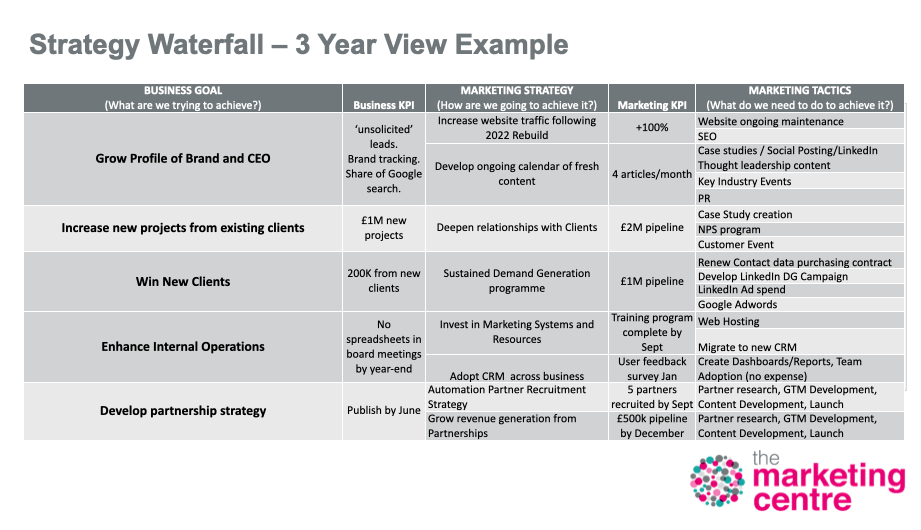It’s time to revise your marketing plan for the year.
In our experience working with different clients, this is something lots of SMEs and junior in-house marketers struggle with.
You might ask for a marketing plan for the year but instead you get back a content calendar or a wish-list of things they’d like to do. This isn’t a strategy, this is tactics.
What is Marketing planning? It is all about understanding your context, setting sensible objectives and then translating those into meaningful activities.
Here's a set of resources that will help create your marketing plan.
Understand your current context
Markets and industries are constantly changing. So, it’s important to understand what changes are happening right now - and how they might impact your business.Here are two quick exercises that help you do that.
The first is PESTLE.
PESTLE stands for Politics, Economics, Social, Technological, Legislation and Environment. It’s a quick exercise that helps you understand how changes in each of these categories will affect your business.
- Politics - How has political context changed for your business? (e.g. recent political instability)
- Economics - What economic changes will impact your business or market? (e.g. a forecasted two-year recession)
- Social - How might changes in social and cultural behaviour impact your business? (e.g. people spending less on discretionary purchases)
- Technological - How might recent changes in how people use technology impact your business? (e.g. more people working remotely)
- Legislation - How might recent changes in legislation impact your business? (e.g. green legislation)
- Environment - Which environmental changes will impact your business or market? (e.g. consumers wanting to save on energy bills)
We should note that PESTLE is a quickfire exercise. Avoid being too detailed with it and trying to note down every single thing that’s changed. Jot down the headlines and move on.
The next exercise is to assess how the changes you’ve identified in your PESTLE exercise might impact your business. You can do this via a SWOT exercise.
- Strengths - What are your strengths?
- Weaknesses - What are your weaknesses?
- Opportunities - Could any of the changes highlighted in your PESTLE actually be opportunities?
- Threats - Which changes identified in your PESTLE could represent a threat to your company?
The combination of these two exercises will give you a better idea of what’s changing in your market and industry, and how these changes can impact your business.
Set the right objectives
When setting your marketing goals, it is important to link them to your wider business objectives. If your business goals and objectives don't link up then they are not able to help take your business to where it needs to be.
Consider:
- What customer segments you want to target
- Which products or services will interest those segments the most
- How marketing will help you reach new customers and shorten your sales process
By understanding your wider business objectives, you can see how marketing can contribute to helping you achieve them. But be sure to distinguish between the business objectives marketing are actually accountable for, versus the ones they aren’t.
Ultimately, setting goals is better than deciding it’s too complex and doing nothing. Set specific, measurable and numerical goals. Even if the goals you initially set turn out to be the wrong ones, you can iterate from there.
Define the strategies you’ll need
Once you’ve set your objectives, you need to translate them into strategies that you can execute.
So, to define which strategies you’ll need, take one of your goals and think about what marketing needs to do to help you achieve it. No need to get too specific at this stage - think big picture.
For example, if your goal is to bring in 100 new customers by the end of the quarter, your strategies could include:
- Doubling your prospect database
- Launch segmented campaigns
- Enable eCommerce
- Use the CRM in a new business process
Rinse and repeat for each of your business goals.
Take a look at how marketing strategy fits into this three-year strategy waterfall example.
Map out the tactics needed to execute your strategy
The next step is to determine your tactics.
Tactics are the specific actions and activities you need to carry out to make your strategies happen.
Let’s use our earlier example.
Your goal is to bring in 100 new customers by the end of the quarter.
Your strategies are:
- Doubling your prospect database
- Launch segmented campaigns
- Enable eCommerce
- Use the CRM in the new business process
So, your tactics might include:
- Revised brochure
- Customer referral process
- Buy contact database
- PPC campaign
- Enhanced trade show programme
- Improved customer onboarding
- Add eCommerce module
- Website usability improvements
- CRM training
For each tactic, assign a key metric to track that will help you measure it against your strategies and business goals. This will help you determine how successful those tactics are and whether you need to make any changes.
Set a measurement framework
Finally, set a framework for how you’ll measure ROI.
We should note that marketing ROI metrics can often be misleading if they’re measuring the wrong thing. There are numerous pitfalls that can seriously obscure your view of how well your campaigns are delivering:
- Vanity metrics - Reporting on reach and impressions can be useful for agencies that want to impress you, but they’re not where you want to focus.
- An incomplete data set - You’ll never have perfect data, but it needs to be good enough to help you make the right decisions
- Getting too granular - ROI at an individual tactic level makes limited sense when there are multiple tactics that all contribute towards a sale. However, ROI at a department level makes perfect sense.
- Only focusing on acquisition - For a true picture of ROI, look at the whole buyer journey and marketing spend across all four marketing pillars (Define, Find, Win and Keep).
- Getting caught up on benchmarks - Base your ROI benchmarks on your own internal targets, spend and strategy. Comparing with others is moot.
To accurately measure ROI, keep things simple.
Here are three key metrics to consider:
- Cost per acquisition
- Customer lifetime value (Dividing customer lifetime value by cost per acquisition will give you a simple measure of the overall return on your marketing investment)
- Marketing costs as a percentage of sales
Measuring these metrics will give you a broad view of whether your marketing campaigns are delivering ROI. Once you know that, go a little deeper and study your pipeline. Look at lead quality and how quickly they convert into sales.
If you’re struggling, see our guide on how to accurately measure ROI - and what to do with your findings.
Want a second opinion?
When it comes to marketing planning, it pays to have years of experience in your back pocket to help you get it right.
Our marketing directors have decades of experience analysing business goals and translating them into meaningful marketing activities.
If you’re struggling with your marketing plan, feel free to get in touch here.



